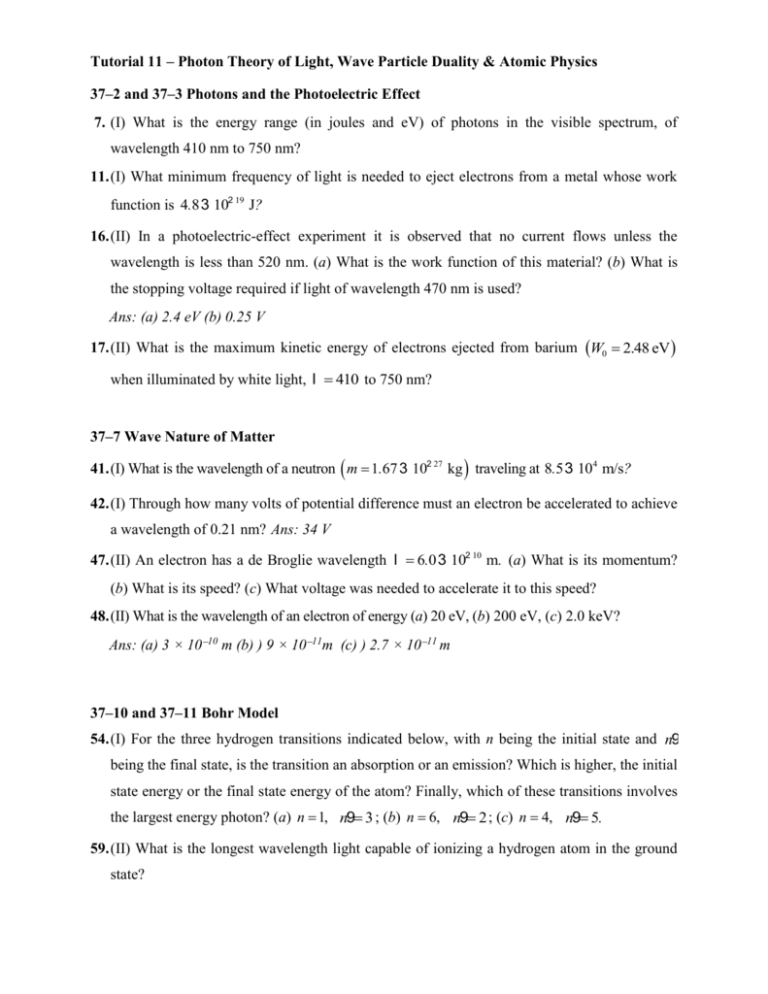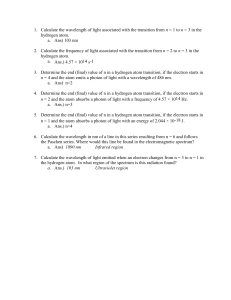Tutorial 11 - Photon, Wave Particle Duality & Atomic Physics
advertisement

Tutorial 11 – Photon Theory of Light, Wave Particle Duality & Atomic Physics 37–2 and 37–3 Photons and the Photoelectric Effect 7. (I) What is the energy range (in joules and eV) of photons in the visible spectrum, of wavelength 410 nm to 750 nm? 11. (I) What minimum frequency of light is needed to eject electrons from a metal whose work function is 4.8 3 102 19 J? 16. (II) In a photoelectric-effect experiment it is observed that no current flows unless the wavelength is less than 520 nm. (a) What is the work function of this material? (b) What is the stopping voltage required if light of wavelength 470 nm is used? Ans: (a) 2.4 eV (b) 0.25 V 17. (II) What is the maximum kinetic energy of electrons ejected from barium W0 2.48 eV when illuminated by white light, l 410 to 750 nm? 37–7 Wave Nature of Matter 41. (I) What is the wavelength of a neutron m 1.67 3 102 27 kg traveling at 8.5 3 104 m/s? 42. (I) Through how many volts of potential difference must an electron be accelerated to achieve a wavelength of 0.21 nm? Ans: 34 V 47. (II) An electron has a de Broglie wavelength l 6.0 3 102 10 m. (a) What is its momentum? (b) What is its speed? (c) What voltage was needed to accelerate it to this speed? 48. (II) What is the wavelength of an electron of energy (a) 20 eV, (b) 200 eV, (c) 2.0 keV? Ans: (a) 3 × 1010 m (b) ) 9 × 1011m (c) ) 2.7 × 1011 m 37–10 and 37–11 Bohr Model 54. (I) For the three hydrogen transitions indicated below, with n being the initial state and n9 being the final state, is the transition an absorption or an emission? Which is higher, the initial state energy or the final state energy of the atom? Finally, which of these transitions involves the largest energy photon? (a) n 1, n9 3 ; (b) n 6, n9 2 ; (c) n 4, n9 5. 59. (II) What is the longest wavelength light capable of ionizing a hydrogen atom in the ground state? 37–10 and 37–11 Bohr Model 54. (I) For the three hydrogen transitions indicated below, with n being the initial state and n9 being the final state, is the transition an absorption or an emission? Which is higher, the initial state energy or the final state energy of the atom? Finally, which of these transitions involves the largest energy photon? (a) n 1, n9 3 ; (b) n 6, n9 2 ; (c) n 4, n9 5. 59. (II) What is the longest wavelength light capable of ionizing a hydrogen atom in the ground state? 35–10 X-Ray Diffraction 49. (II) X-rays of wavelength 0.138 nm fall on a crystal whose atoms, lying in planes, are spaced 0.285 nm apart. At what angle f (relative to the surface, Fig. 35–28) must the X-rays be directed if the first diffraction maximum is to be observed? 50. (II) First-order Bragg diffraction is observed at 26.8° relative to the crystal surface, with spacing between atoms of 0.24 nm. (a) At what angle will second order be observed? (b) What is the wavelength of the X-rays? Ans: (a) 64.4 (b) 0.22 nm 39–6 X-rays 38. (I) If the shortest-wavelength bremsstrahlung X-rays emitted from an X-ray tube have l 0.027 nm, what is the voltage across the tube? Ans: 46 kV









